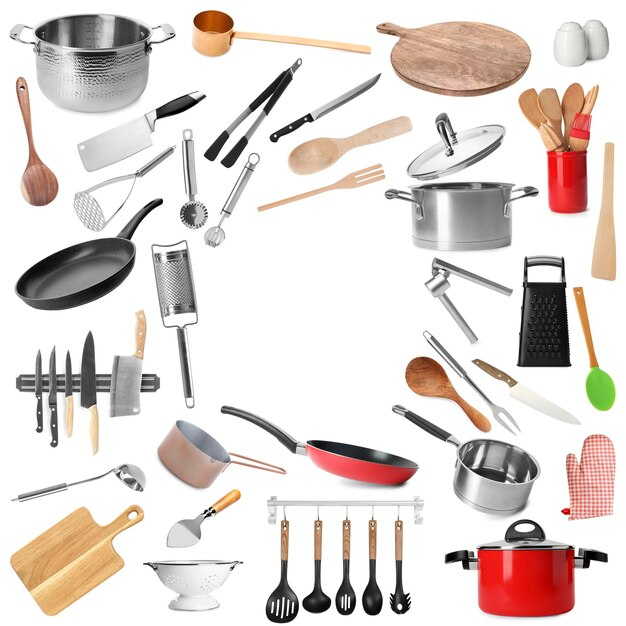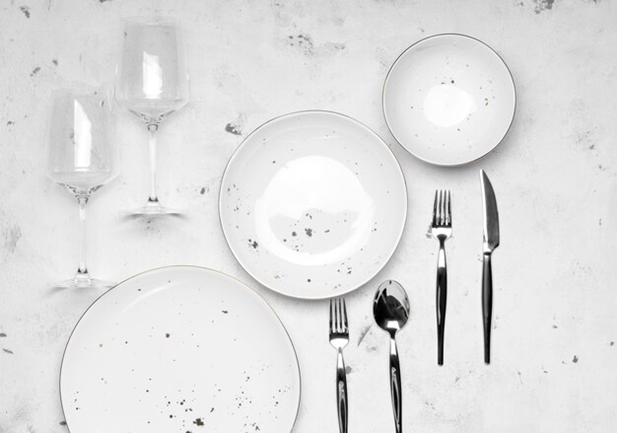54 9.4: Kitchenware and Tableware
9.4 – Kitchenware and Tableware
The FDA Food Code, section 4-904.11, outlines crucial guidelines for handling kitchenware and tableware to prevent contamination and ensure food safety in food service establishments (FDA). This section emphasizes the importance of proper handling, display, and dispensing of single-service articles, single-use articles, and cleaned and sanitized utensils (FDA).
The primary objective of these guidelines is to prevent contamination of food-contact and lip-contact surfaces. This is particularly important in self-service settings, where multiple customers may come into contact with serving utensils and food items (FDA).

Image Courtesy of Freepix
Handling of Utensils
Knives, forks, and spoons that are not pre-wrapped require special attention. The code stipulates that these utensils should be presented in a way that only the handles are touched by employees and consumers. This practice significantly reduces the risk of transferring pathogens from hands to the food-contact surfaces of the utensils (FDA).
According to the food code, tableware means eating, drinking, and serving utensils for table use such as flatware including forks, knives, and spoons; hollowware including bowls, cups, and serving dishes.
______________________________________________________________________________
Preventing Contamination
The Food Code describes utensils as food-contact implements or containers used in various aspects of food handling, including storage, preparation, transportation, dispensing, sale, or service of food. The definition of utensils encompasses several categories:
Multiuse utensils: These are items that undergo warewashing (cleaning and sanitizing) after use and before reuse. Examples include kitchenware, tableware, and multiuse gloves.
Single-service utensils or single-use articles: These are items intended for one-time use and are discarded after use. Examples include disposable plates, spoons, and disposable gloves.
Specific items utensils: The definition also includes temperature sensing probes of food temperature measuring devices and probe-type price or identification tags used in contact with food.
*** It’s important to note that the Food Code distinguishes between multiuse utensils that require warewashing and single-use items that do not. Multiuse utensils must be cleaned and sanitized according to specific sections of the Food Code, while single-use items must be made of safe materials and inspected for proper specifications before use.
Single-Service Articles
For single-service articles intended for food or lip contact, the code provides two acceptable methods of presentation to ensure that the food-contact surfaces remain protected until the moment of use, minimizing the risk of contamination.
Keeping the original individual wrapper intact.
Dispensing product from an approved dispenser.
According to the CDC, contaminated utensils and food-contact surfaces can contribute to the spread of pathogens that cause foodborne diseases (Cleaning Institute). By following these practices, food service establishments can significantly reduce the risk of cross-contamination and protect public health (FDA Food Code, 2022).
Soiled and Clean Tableware
The FDA Food Code, section 4-904.12, addresses the critical issue of managing soiled and clean tableware in food service establishments. This provision aims to prevent cross-contamination between used and sanitized items, which is essential for maintaining food safety standards. Proper handling of soiled tableware is crucial to prevent the spread of pathogens. When removing dirty dishes from consumer areas, food service workers should exercise caution to avoid contact with clean items. This practice helps maintain the sanitary condition of clean tableware and reduces the risk of foodborne illness transmission. To elaborate on this concept:
Separate handling: Staff should use dedicated trays or carts for transporting soiled tableware, keeping them physically separated from clean items during the removal process.
Immediate processing: Soiled tableware should be promptly moved to the dishwashing area to minimize the potential for bacterial growth and cross-contamination.
Hand hygiene: Employees must wash their hands thoroughly after handling soiled tableware and before touching clean items to prevent the transfer of pathogens.
Storage considerations: Clean tableware should be stored in a manner that protects it from contamination, such as in enclosed cabinets or with the eating surface facing downward.
By adhering to these practices, food service establishments can significantly reduce the risk of contamination and ensure that clean tableware remains safe for customer use.
Preset Tableware
The FDA Food Code, section 4-904.13, requires the proper handling of preset tableware in food service establishments to prevent contamination (FDA Food Code). This regulation aims to maintain food safety standards by protecting utensils and dishes from potential contaminants before customer use. Preset tableware refers to plates, glasses, and utensils arranged on tables prior to customers being seated.
This precautionary measure helps minimize the risk of exposure to airborne particles, dust, or other potential contaminants that could compromise food safety. However, the code provides two exceptions to this rule :
If unused place settings are removed when a customer is seated, exposed tableware is permissible.
If settings remain on the table after a customer is seated, they must be cleaned and sanitized before being used by another patron.
These exceptions allow for flexibility in restaurant operations while still maintaining high standards of hygiene. By requiring the removal or sanitization of exposed tableware, the code ensures that customers are provided with clean, uncontaminated dining implements. This regulation is part of a comprehensive approach to food safety that includes proper food handling, temperature control, and personal hygiene practices among food service workers (FDA Food Code).
The Food Code defines personal hygiene as clean and healthy practices regarding the body to prevent harboring and transmission of harmful microorganisms. For food handlers, it includes specific mandatory requirements when working with or around food. Good hygiene habits are equally important during the service and holding of food. As a reminder, the key aspects of personal hygiene in the Food Code include:
Handwashing: The Food Code specifies proper handwashing procedures, including the minimum length of time required, recommended frequency, and appropriate water temperature. It emphasizes the importance of handwashing in preventing foodborne illness and cross-contamination.

Image courtesy of Freepix
____________________________________________________________________________
The Food Code stipulates that to be protected from contamination, tableware must be – wrapped, covered, or inverted.
- Personal cleanliness: Food handlers are required to bathe daily, keep fingernails neat and trimmed, and wear clean uniforms and aprons.
Hair restraints: Long hair should be pulled back into a ponytail or bun.
Bare hand contact: The Food Code prohibits bare hand contact with ready-to-eat (RTE) foods.
Glove use: Single-use gloves should be used for one task and replaced when damaged, soiled, or when interruptions occur.
Jewelry restrictions: Food handlers should not wear jewelry on hands and arms except for a plain ring, like a wedding band.
Health conditions: Employees experiencing persistent sneezing, coughing, or runny nose should not work with exposed food.
Designated areas: Eating and drinking should only occur in designated areas to avoid contamination of food, equipment, and utensils.
